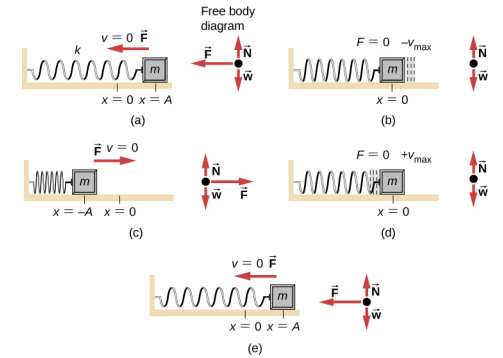Simple Harmonic Motion
Notes
A very common type of
periodic motion
is called simple harmonic motion (SHM)
. A system
that oscillates with SHM is called a simple harmonic oscillator
.In simple harmonic motion, the acceleration of the
system
, and therefore the net force
, is proportional to the displacement
and acts in the opposite direction of the displacement
.A good example of SHM is an object with mass attached to a spring on a frictionless surface, as shown in Figure . The object oscillates around the
equilibrium position
, and the net force
on the object is equal to the force
provided by the spring. This force
obeys Hooke’s law
Fs = −kx, as discussed in a previous chapter.If the net
force
can be described by Hooke’s law
and there is no damping (slowing down due to friction
or other nonconservative forces), then a simple harmonic oscillator
oscillates with equal displacement
on either side of the equilibrium position
, as shown for an object on a spring in Figure . The maximum displacement
from equilibrium
is called the amplitude (A)
. The units
for amplitude and displacement
are the same but depend on the type of oscillation
. For the object on the spring, the units
of amplitude and displacement
are meters.
simple harmonic oscillator
. In the above set of figures, a mass is attached to a spring and placed on a frictionless table. The other end of the spring is attached to the wall. The position
of the mass, when the spring is neither stretched nor compressed, is marked as x = 0 and is the equilibrium position
. (a) The mass is displaced to a position
x = A and released from rest. (b) The mass accelerates as it moves in the negative x-direction, reaching a maximum negative velocity at x = 0 . (c) The mass continues to move in the negative x-direction, slowing until it comes to a stop at x = −A . (d) The mass now begins to accelerate in the positive x direction, reaching a positive maximum velocity at x = 0 . (e) The mass then continues to move in the positive direction until it stops at x = A . The mass continues in SHM that has an amplitude A and a period T. The object’s maximum speed occurs as it passes through equilibrium
. The stiffer the spring is, the smaller the period T. The greater the mass of the object is, the greater the period T.What is so significant about SHM? For one thing, the period and frequency of a
simple harmonic oscillator
are independent of amplitude. The string of a guitar, for example, oscillates with the same frequency whether plucked gently or hard.Two important factors do affect the period of a
simple harmonic oscillator
. The period is related to how stiff the system
is. A very stiff object has a large force constant (k)
, which causes the system
to have a smaller period. For example, you can adjust a diving board’s stiffness—the stiffer it is, the faster it vibrates, and the shorter its period. Period also depends on the mass of the oscillating system
. The more massive the system
is, the longer the period. For example, a heavy person on a diving board bounces up and down more slowly than a light one. In fact, the mass m and the force
constant k are the only factors that affect the period and frequency of SHM. To derive an equation for the period and the frequency, we must first define and analyze the equations of motion. Note that the force
constant is sometimes referred to as the spring constant.
